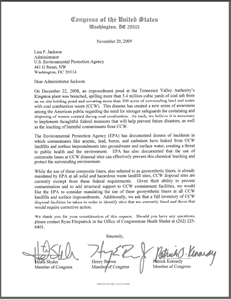 The Geosynthetic Materials Association (GMA) has worked with various Congressional figures over the past few years on key issues in the United States infrastructure. One area in which GMA has been particularly active is in bringing proper coal ash containment technologies to the attention of legislators.
The Geosynthetic Materials Association (GMA) has worked with various Congressional figures over the past few years on key issues in the United States infrastructure. One area in which GMA has been particularly active is in bringing proper coal ash containment technologies to the attention of legislators.
A new letter from GMA Executive Director Andrew Aho helps illuminate this issue and the exemplary work GMA has done. Representatives such as Heath Shuler (D-NC) have taken notice and are working diligently to improve Congressional awareness of this much-needed environmental protection.
It’s certainly an issue worth noticing, and we are happy to see the US Congress and Environmental Protection Agency (EPA) moving closer to using geosynthetics just as are included in regulations for the waste management field. Waste management has been the most highly rated sector of the country’s infrastructure. Andrew’s letter follows with a link to an important letter sent to EPA Administrator Lisa P. Jackson.
– Chris Kelsey, Editorial Director, Geosynthetica.net
LETTER FROM GMA
 Dear GMA member,
Dear GMA member,
As you are aware, our government relations program added coal-ash regulation to our work plan after the disaster in Tennessee last December. We are pleased to report significant progress in our efforts to require EPA regulation of coal-ash waste sites, regulations that when in place will benefit ALL of our member companies.
Attached is a letter signed by three influential members of Congress requesting that the EPA require the use of geosynthetic liners in coal-ash waste sites. Additionally, Rep. Heath Shuler’s office is now beginning to draft legislation on the need for lining at coal-ash sites nationally.
During the past two months, GMA has provided citations and information for the early draft of this bill. Rep. Shuler’s office is excited that GMA is committed to this issue and willing to be an ongoing resource for his office.
When we are successful in this effort, coal-ash sites will be lined with geomembranes and geosynthetic clay liners. Geocomposite drains will dewater the coal ash. Geotextiles and geogrids will reinforce the dikes and slopes of the coal-ash sites, as well as the access roads to the sites. Erosion control mats and degradable rolled erosion control products will stabilize the slopes. Manufacturers, distributors, installers, fabricators, and service providers of geosynthetic materials will all benefit from this work.
As an organization we can be proud of the work and the progress of our Government Relations Program. Not only is the coal-ash issue moving forward, but our Geotextile Separation Study is teed up and ready when Congress takes up the Transportation Reauthorization Bill, and we are developing our request for geosynthetic research to be funded by the Water Resources Development Act.
Our thanks goes out to the GMA members that have provided time and resources reaching out to Congress, providing expertise and financial support for the GMA Government Relations Program.
Andrew Aho, Managing Director
Geosynthetic Materials Association











